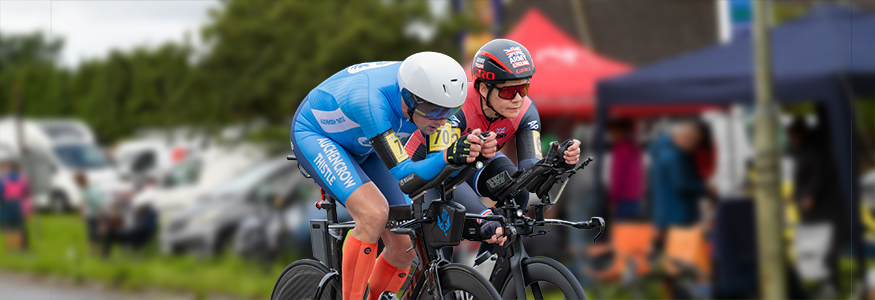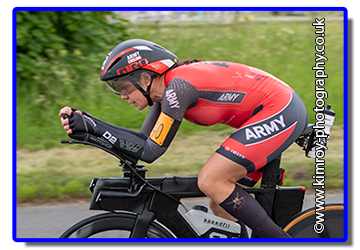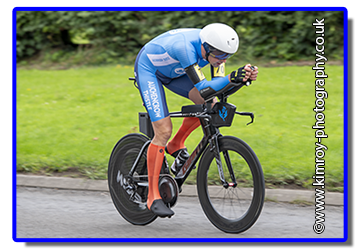
Fuelling for a 24-hour event is seen as one of the most complex parts of the discipline with riders opting for different approaches.
Keeping energy stores full for the longest of the Cycling Time Trials distances is as important as having the correct training.
Three-time women’s national champion Chris Murray learnt the hard way during her first attempt at the discipline in 2018 stopping after 16 hours of riding.
The Army Cycling rider returned the following year to win with a competition record of 478.4 miles before increasing her margin to 490.2 miles in 2021.
This year saw competitors battle wet conditions and Murray won her third 24-hour title with a distance of 465.3 miles.
Joanna Cebrat (360cycling) finished second in this year’s women’s event with 419.2 miles and Amy Hudson (Velo Bavarian) third on a road bike in 394.2 miles.
Robbie Mitchell (Auchencrow Thistle CC) won his first National 24-hour title in the men’s event, completing 519.3 miles in the time to finish ahead of Mark Turnbull (TORQ Performance) in second (511.1 miles) and Timothy Welsh (Cambridge CC) in third (501.5 miles).
Murray says that there is no book or guide to read which can help you through a 24-hour event.

“A lot of people have views or opinions, but ultimately everybody’s body is different so what can work for one person might not work for another,” she said.
“It is through trial and error and a voyage of discovery. You just don’t know until you do a 24-hour. It’s unlike a marathon where people will do an 18-mile run in training which you can recover from fairly quickly.
“If you’re doing a 24-hour there’s kind of a limit to how far you can do in a test ride, you might do 16 hours but then that’s still a mammoth thing to do on a bike in training which would need numerous weeks of recovery.”
In this year’s event competitors not only had the distance to content with but also prolonged wet weather and there were 12 non-finishers.
The night-time hours are seen as the toughest in the 24-hour as the body screams out for sleep and with half the event still remaining.
Murray says that discipline and forcing yourself to eat at regular intervals is key to lasting the 24-hour distance.
“If the body says you don’t want to eat and you don’t, then the ability to turn the pedals goes away as there’s not enough fuel in the fire,” she added.
“That for me is when the challenge starts to come in, particularly the night-time and when the body is doing something it’s not used to.
“That’s particularly hard to rehearse because even if you went on a 12-hour rider overnight you’d survive. While if you’re going overnight and get to 7am with eight hours left to push that’s still quite a long ride.
“I always view that I’m not eating for now, but eating for eight hours’ time to make sure that I’m still going.
“One of the really hard things is mind over matter, even though you don’t want to eat because you’re not hungry, you’ve still got to because it’s fuel.”
The food riders eat can also vary massively during a 24-hour event with some choosing to stop and eat a hot meal while others prefer to ride throughout and take on food as they compete.
Murray sees nutrition as the ‘most complex and challenging part’ of a 24-hour event and she starts refuelling with snacks 30 minutes into the event.
However, she says that every rider is different and there is also a risk of over-carbing which can make competitors feel ill or dizzy.
The national champion says that her nutrition strategy changes race to race and she tries to find foods which are easy to digest that she won’t get bored of eating.

National men’s title holder Mitchell has a less flexible approach to his nutrition plan and has a tried and tested method.
“I’ve got a tried and tested way now because I’m lucky enough or silly enough to have done several 24-hour efforts,” he said. “I’ve kind of found what I can and can’t get away with in the build-up to and during.
“I’ve got a pretty nailed down schedule and there’s very little deviation from that. We do a repeat four-hour cycle of fuel, it’s about keeping it simple with stuff that you know works for yourself.
“I couldn’t sit and tell people what to eat and drink, I really had to find that out the hard way.”
Mitchell said that he learnt which food works for him during long 12-hour training rides.
* All reports and features are copyright of Cycling Time Trials/Snowdon Sports. Not to be used without permission.
